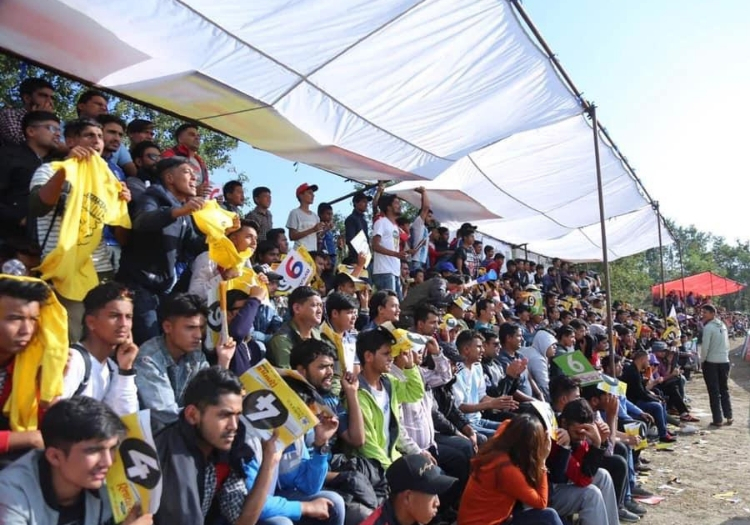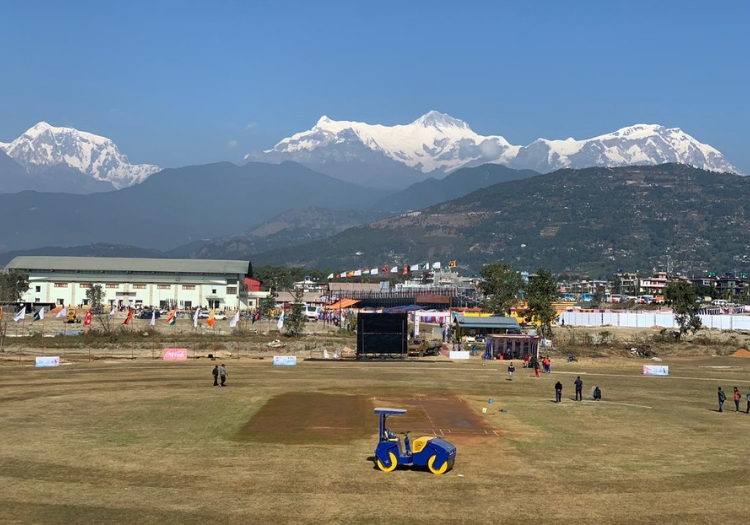Established last year, the PPL is Nepal’s third T20 league but has designs on becoming the gold standard for franchise cricket in the mountainous country
The scene is as beautiful as you will find for a cricket ground. The backdrop is the imposing Annapurna mountains; the tops are serrated edges tearing at the beautiful blue sky supplying the snow-capped Himalayas with contrast. The ground itself affords far less majesty but is the home of Nepal’s Pokhara Premier League (PPL). Sitting at 1,400m above sea level, Pokhara Rangasala is a multi-purpose stadium where matches are played. This year’s tournament will run from December 14th to 28th in Nepal’s second most populous city.
The city of Pokhara sits about 200km to the west of Nepal’s Kathmandu and is the tourism capital of the country. Due to its proximity to three of the world’s ten highest mountains, the valley where Pokhara is situated is ideal for mountaineers to begin their assault. Remarkably, the city was only accessible by foot until the late 1960s but now boasts a growing economy due to tourism and ever-developing urbanization.
Sport plays a large part of life in Pokhara with football and cricket featuring as well as the abundance of options for outdoor sports. Pokhara does not have a dedicated cricket stadium yet despite having a cricket presence in the form of the Pokhara Rhinos in the Everest Premier League (EPL) as well as the PPL.
Established last year, the PPL is Nepal’s third T20 league but has designs on becoming the gold standard for franchise cricket in the mountainous country. The idea of the league, according to Marketing Head Ayush Gautam, is to “decentralise” cricket from Kathmandu while leveraging tourism in the area. The first edition was held in 2018 with 17 matches in total featuring six teams: Biratnagar Titans, Butwal Blasters, Chitwan Rhinos, Expert Dhangadhi Blues, Kathmandu Golden Warriors and Pokhara Paltans. Pokhara won the final, in front over 5,000 fans, when they beat Chitwan who were captained by ex-Nepal captain Paras Khadka.
.jpg)
Each team’s roster was predominantly made up of local talent. However, there were a few players from outside of Asia who came to Nepal to play. One of the players who featured in last season’s tournament was Peter Trego. The all-rounder admitted that Nepalese cricket was unknown to him when he arrived in the country, but Trego soon found that he was impressed with the quality of the play. Despite the distinct challenges of a start-up competition, which have been evident with competitions such as the Euro T20 Slam not getting off the ground, Trego was complimentary about his time in Nepal.
“The challenge for an Englishman playing there was the surface. I was fortunate to have a lot of experience of spinning sub-continent type pitches so coped well. The ground itself was basically a club ground with temporary stands but as it was framed by Machhapuchhare and Annapurna mountains. It was possibly the most stunning ground I’ve ever played at.”
Trego continued, “The hospitality I experienced was second to none I’ve ever experienced in twenty years as a pro and would love to return to Nepal to play again.”
The PPL aims to boost cricket in Nepal; not just for assisting international cricket to grow but for the numerous cricket fans. The league management team state that “producing tournaments like PPL will increase exposure for players, assist in the infrastructural development of cricket, and we will have regular cricket in domestic level as well.” Another stated aim is to elevate the status of the city for tourism and, consequentially, reap the economic benefits.
The PPL does not have a monopoly on franchise cricket. It is indirectly competing with two other leagues. The Dhanghadhi Premier League (DPL) and the EPL are older than the PPL and have a better foothold on Nepal’s domestic cricket schedule. All three leagues have a six-team structure, but there appears to be a place for all three to co-exist. In a time where there is a saturation point in T20 cricket, Nepal is not there. The leagues have the capacity to provide additional jobs as well as meeting the fans’ desire for cricket.

Rajan Shah is the Team Director of Butwal Blasters and has an ebullient outlook on the prospects for the PPL and cricket in Nepal, “If DPL and EPL learned season by season, PPL has come as a matured version of the T20 leagues. EPL remains its biggest competitor, but that is healthy for both the leagues. There are shortcomings in all three leagues, but they have helped keep Nepali cricket commercialized and recognizable even in the absence of CAN [Cricket Association of Nepal]. PPL is most popular among Nepali cricket players.”
The success of the PPL is intrinsically linked to the success of cricket in Nepal. Cricketers such as Sandeep Lamichhane are not unique. There will be other quality Nepali cricketers out there and having a showcase for their talents will help bring them to the fore. In turn, the national team will grow. However, CAN needs to ensure that the required steps are in place so that the ICC’s conditional membership reinstatement becomes permanent.
CAN had been deemed, in 2016, to be in breach of regulations that require governments not to interfere and keep elections free and fair. Recent board elections that were overseen by an independent panel gave ICC comfort to reinstate CAN as a member. It would be a shame if Nepali cricketers, discovered by such tournaments, were not given a chance to play at the highest level. The ICC had allowed Nepal to compete despite the suspension of membership, but that would have been revoked had CAN not addressed its governance issues.
There are issues that CAN still need to sort such a formulating a strategic plan to move the game forward. The PPL will be an essential part of that strategy. Nepal still lacks a dedicated cricket stadium. As beautiful a view as Pokhara Rangasala has, the facilities need to be improved. That will require the co-operation of governments and landowners to finance such as outlay.
The first ball of season two will be bowled on Saturday, and the PPL will be showcasing cricket in Nepal, not just Pokhara. Fans will flock to the picturesque ground as they did in the first season. Those that can’t attend the games will watch via Himalaya TV or online. The challenge is to grow the market, and it will be difficult with the Bangladesh Premier League and the Big Bash League as competitors. If the second season builds on the foundations laid last year, the PPL will soon be soaring like the mountains that surround it.

